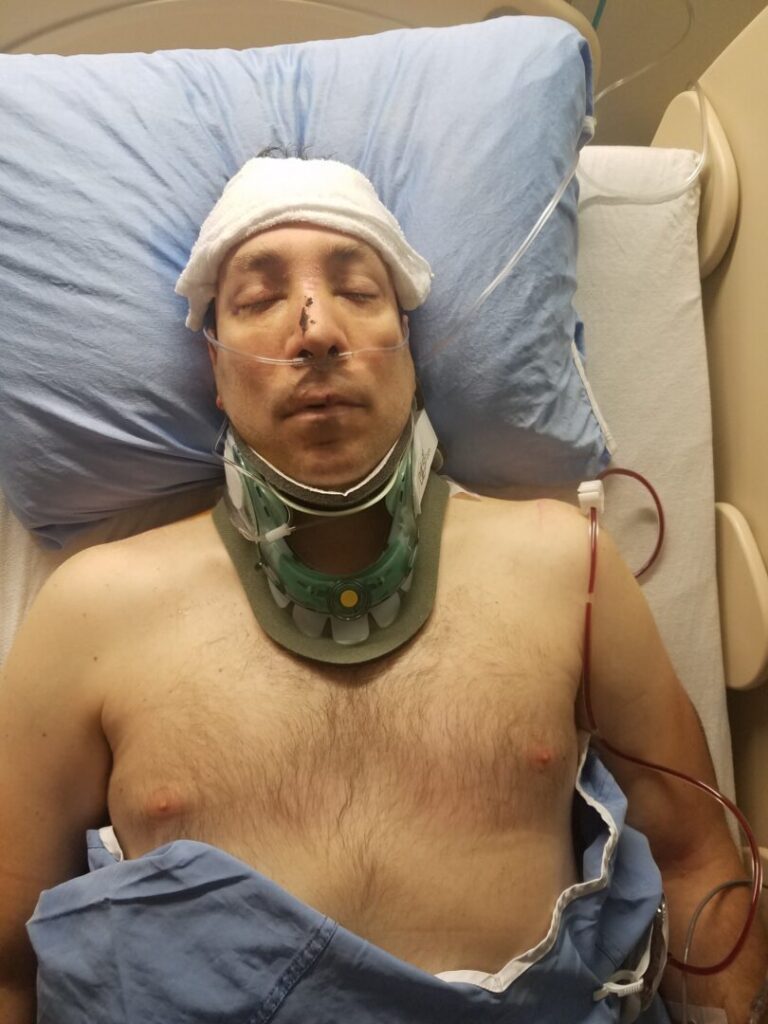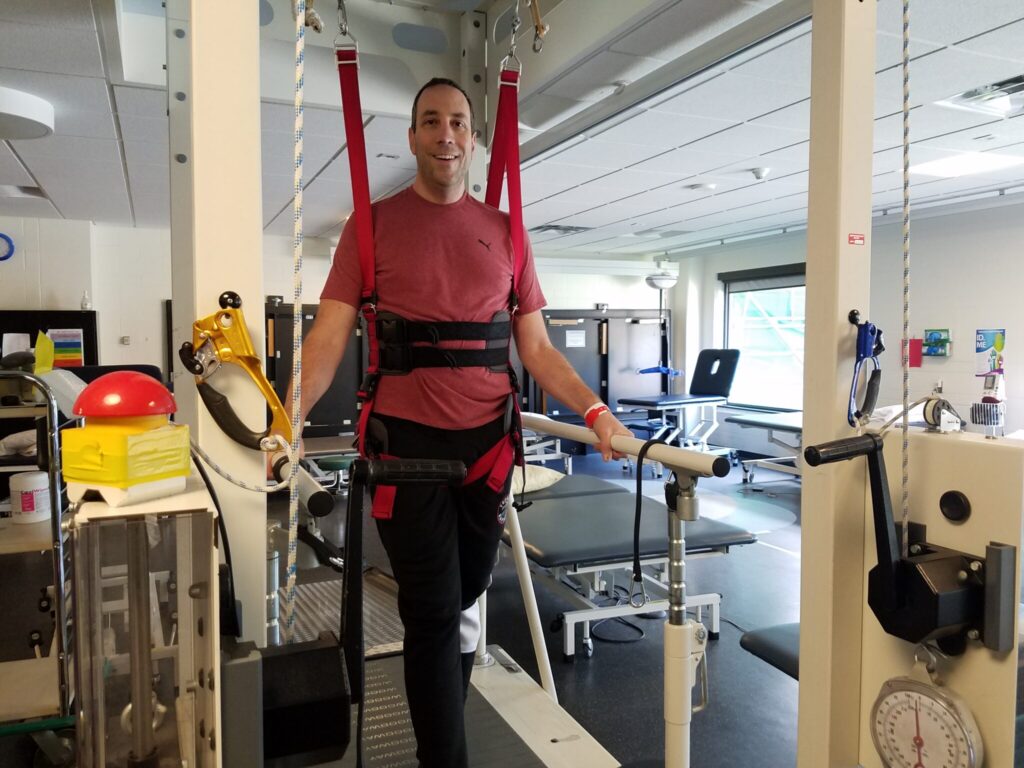Former trauma patient on his journey of healing, and why despite ongoing challenges, he is “thrilled to be here”
By Idella Sturino | May 17, 2024

It was a bright and beautiful Sunday morning when Devin and a friend set out on their mountain bikes for what they expected would be another fun trail ride through the forested areas surrounding King City, Ontario.
At first, the only thing that set the day in September, 2019, apart from past mountain bike adventures was the fact Devin (who asked that only his first name be used for this story) agreed to borrow his friend’s spare helmet for the ride.
“It was just a normal, perfect morning,” Devin says.
But after riding along the winding and hilly trails for a while and picking up speed, Devin’s normal and perfect day took an unexpected and traumatic turn.
“At the bottom of a hill, I came around a bend and saw a tree root above ground,” he says. “That was the last thing I saw before I lost consciousness.”
When Devin came to, he realized he had hit the tree root and flipped over the handlebars of his bike, landing hard face down on the ground. His arms were pinned underneath him and his mouth was full of dirt. He struggled to breathe but managed to call out to his friend up ahead.
“I said, ‘I can’t move, I can’t feel anything below my neck! I feel like my body is floating in the air,’” Devin recalls.
His friend quickly called 911 and the two men waited for help to arrive in the form of an air ambulance. Given the secluded area, it took more than an hour for the helicopter to get there – a harrowing wait that presented Devin with a mental challenge on top of his physical crisis.
But after a brief moment of panic, Devin – a manufacturing manager by profession who is accustomed to forward planning – turned his attention to mapping out how he would adjust his day-to-day life to accommodate his new injury.
“I started thinking, okay, we’ll need to bring the bed into the living room and build a wheelchair ramp to the house, because I thought I wasn’t going to be able to move again,” Devin explains.
Just before paramedics arrived, however, Devin felt a glimmer of hope when he noticed a tingling sensation in his right big toe. Then, once paramedics were on the scene and carefully turned him over to put a neck collar on and place him on a stretcher, Devin says it was like a switch flipped. He suddenly went from not being able to feel much at all to experiencing agonizing pain.
“It was like fire, lightning, electric shock, someone hitting you with a baseball bat and being jabbed by two million needles all at once,” Devin explains. “It was every kind of pain you can think of to the hundredth degree.”
Despite the pain, Devin says he was relieved: “I was just glad I could feel again.”

Devin says he overheard paramedics briefly discuss whether to take him to a regional hospital or Sunnybrook Health Sciences Centre, home to the Tory Trauma Program and Canada’s first and largest trauma centre. Once they realized the extent of his injuries, the decision was clear.
“Someone said, ‘He needs to go to Sunnybrook!’” Devin recalls. “And it was like, boom, end of discussion.”
Once Devin arrived at Sunnybrook, doctors and nurses in the trauma bay, which is a special part of the emergency department used only for the care of trauma patients, immediately sprang into action.

“They were absolutely incredible,” Devin says of the trauma team that quickly mobilized around him. Trauma teams include specialists with the training and skills to provide emergency care and life-saving procedures.
“By that point, I had some degree of feeling in my lower extremities, but I told them I thought I had shattered all the bones in my arms and wrists because I was in so much pain and couldn’t move my arms,” Devin says. “They had the X-ray machine out within seconds.”
After reviewing the results from Devin’s X-rays as well as other tests, including an MRI and CT scan, doctors informed him that none of his bones were broken. They explained the pain Devin felt was nerve pain resulting from compression on several discs and a spinal cord injury known as central cord syndrome. The accident had also left Devin with a dislocated shoulder, a concussion, and permanent damage to his brain’s frontal lobe.
“Many people told me they were amazed that I survived the impact of the accident,” Devin says, adding he believes the helmet he borrowed from his friend played a part.”

Doctors recommended Devin undergo neck surgery to relieve the pressure on his nerves and restore movement to his arms. But they said first, he would need to be able to tolerate lying on his side long enough to undergo and recover from the procedure – something Devin found hard to fathom given the extent of his pain.
That’s when Jason Sawyer, a pain management nurse practitioner with Sunnybrook’s Acute Pain Service, was brought onto Devin’s highly-specialized interprofessional care team to assist.
Devin calls Jason “a godsend.”
“Jason asked me where I was from zero to ten on the pain scale, and I answered five hundred,” Devin says. “He said we needed to figure out how to get me onto his pain scale.”
Using a pain neuroscience education lens, Jason worked with Devin to help him better understand his pain – which was so intense that even the sensation of air breezing past was excruciating – and the emotional distress that went along with it. Together, they devised a unique pain management plan that included pharmalogic and non-pharmalogic components.
“I was going to do whatever was required to have some sort of normal life again,” Devin recalls.
About a week later, Devin was cleared for surgery.
A few days after that, with the support of an occupational therapist and physiotherapist, he was able to begin walking again. He was then discharged to a rehabilitation centre before eventually returning home.

Jason says there were many important factors that contributed to Devin’s remarkable recovery.
“Having access to many pharmacologic interventions, particularly lidocaine and ketamine infusions, was an important component of navigating pain management in this complex case,” he says.
He also credits Devin’s “positivity, strong support network, and relatively good physical health” at the time of injury.
Asked about his positive attitude, Devin says: “If you focus on negativity then you can’t focus on healing.”
But he is quick to add the support of his family, especially his wife, and his Sunnybrook care team was just as essential to his recovery.
Now, nearly five years after he first arrived at Sunnybrook as a trauma patient, Devin is finding satisfaction in a new job, enjoying time with his wife and their two adult sons, and looking forward to new adventures ahead such as travelling abroad.
The path to get to this point, Devin admits, was long and difficult. After he was discharged from the hospital and rehabilitation centre, his return to health took several years. Ongoing nerve pain made things like showering while standing, wearing long sleeves, sleeping on his side, or venturing outdoors on a crisp day without gloves years to achieve.
Even now, Devin says he is restricted in certain movements and copes with ever-present but manageable mild pain, including nerve pain in his arms and hands. For example, the sensation of water hitting his arms in the shower still hurts. His neck sometimes bothers him too if he has neglected his physiotherapy exercises for a few days. But Devin says he is happy with how far he has come, and he is more focused on what he can do than what he can’t.
“It was a goal of mine to get at least this far and if this is the best I will be, that’s fine,” he says. “I can’t skate or go mountain biking but things could be worse.” He adds that he now enjoys leisurely bicycle rides with his wife for exercise instead.
And in his spare time, he has started playing guitar again for the first time in years.
“My hands will never be the same, but I am okay with that because I can still strum my guitar,” Devin says.
Adds Devin simply: “It’s a busy life. I am thrilled to be here.”
About This Article:
A Life Worth Living has copied the content of this article under fair use in order to preserve as a post in our resource library for preservation in accessible format. Explicit permission pending.
Link to Original Article: https://health.sunnybrook.ca/featured/thrilled-to-be-here/

